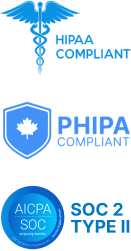Home > Blog > Documentation and Private Practice (Free Samples Included!)
Documentation and Private Practice (Free Samples Included!)
Author: S Anandavalli, PhD, NCC, LPC, CCTP
Have your progress notes written for you automatically
The anxiety and stress of starting a practice as a clinician is familiar to many who have started this journey. While licensed professional counselors, psychologists, and social workers are trained very well to treat their clients’ mental health issues, we are rarely taught the administrative side of this process. Specifically, the documentation aspect of being in practice. Thus, it is very normal and common for new practitioners to ask questions like “what forms do I need to run my practice smoothly?”, or “what documents would my clients need as they complete the initial packet before the intake session?”.
In this article, we outline the most important documents and forms you will need to cover your bases as a psychotherapist. While we provide outlines on how you can develop one on your own, we will also provide you with a list of freely available such documents!
List of Key Documents
1. Professional Disclosure Statement/Informed Consent
This is an absolute key document that most mental health professionals will need. In many state boards such as the Oregon Board of Licensed Professional Counselors and Therapists will insist that failure to provide new patients with a PDS is an ethical violation. Thus, in many ways, this is the first document you will need.
A great way to develop this is to carefully review the requirements outlined by your state agencies. An example can be found here. A list of state counseling agencies and their websites can be found here.
Three top tips to make your PDS clear and easy to understand is to
1. Your name and credentials
2. Include a section on confidentiality principle
3. Your therapy philosophy
4. Your work experience and expertise
5. Include information about how they may resolve if any concerns come up in the therapeutic relationship
6. Your and client signature
2. Intake
This is perhaps the most clinician specific document. Each clinician with their own unique philosophy will have a different version. Additionally, depending on the clinician’s niche and expertise, some additional sections such as sexual trauma history, substance use , or even autism. Thus, look at your expertise and add relevant sections that gather valuable information.
Even as you customize your intake form, be sure to include fundamental sections such as
1. Client name, gender, preferred pronouns, and age
2. Mental health history
3. Emergency contact information
4. Current and past medical health issues
5. Hospitalization history
6. Family history of mental health issues
7. Trauma/Abuse/Violence history
8. Suicide and self-harm risk evaluation
9. Cultural and spiritual identity
10. Goals for treatment
A few general intake forms samples are included below;
3. Consent for Telehealth Consultation
With the advent of the post COVID-19 era, more and more practices are moving towards giving options of telehealth. This is a great strategy to widen the network of potential clients who may reach you. In fact, many organizations now offer a telehealth certification to ensure that clinicians are well aware of the ethical and legal requirements to conduct telehealth sessions.
One such organization is the NBCC which offers the Board Certified Telemental Health Provider credential so that practitioners can assure clients that they are in fact well trained on this platform. Evergreen Certification also offers a similar credential on Telemental health counseling.
Practitioners are encouraged to consider these options as they structure their practice. In addition to gathering such certifications, it is imperative that practitioners also check with their local State counseling Boards to ensure they meet the requirements.For instance, California laws for Marriage and Family Therapists outline that while a written consent is not needed for telehealth, it must be verbally communicated and documented in the practice.
In general, all telehealth consent forms include information on
1. the risks and benefits of engaging in this approach.
2. What clients can expect if the session is suddenly disrupted either due to technical issues or spam.
One such example of including a plan of action in case of disruption or emergency is included in this sample. It is also a great practice to request for emergency contact information in case the client cannot be accessed during the appointment. This information is included appropriately in this sample.
4. Release of Information
Mental health practitioners must recognize that we often work as a multi specialty team. Counselors often need the support of other experts including psychiatrists, dieticians, and physical therapists.
ROI in general must include the following basic information:
1. Client name and date of birth
2. Clinician’s name and credentials
3. The list of organizations and individuals who are being authorized to access client information
4. The categories of information (e.g., diagnosis)
5. The time period (both start and end date) for the validity of the ROI
6. Client signature and date
A few sample release of information are included here:
Sample 3 (for children)
5. Session or Progress Notes
Documenting the summary of each counseling session becomes imperative for numerous reasons including insurance reimbursement. Clinicians must ensure that they complete
progress notes in a timely manner with adequate details. The nature of details clinicians capture may depend on their clientele (e.g., (clients experiencing intimate partner violence) and the main audience for their notes e.g., counselors seeing court mandated clients may need to provide clinical notes or summary). In general, a standard progress notes must include the following information:
1. Date and time of the clinician appointment
2. Presenting issue or problem as defined by the client
3. Counselors’ observations and evaluation of the client’s problems
4. Interventions employed by the counselor to address the issue
5. Plans for the future appointments
At present various session notes formats are available for free. Few popular ones include
1. DART Notes
2. SOAP Notes
3. DAP Notes
6. Fee Agreement/Compensation
Depending on the nature of the practice, some clinicians see only private pay clients while others accept various insurance. The decision on whether to accept insurance in practice is a deeply subjective one. It depends on various factors such as
1. The expectations of the organization/counseling agency clinician is affiliated with 2. Type of psychotherapy provided (e.g., psychodynamic approaches or family therapy are not often supported by some insurances)
Irrespective of the decision to accept insurance or not, clinicians must clearly communicate their compensation to their clients. Signing a fee agreement thus is an important document. Clinicians should include the following information in their fee agreement:
1. Name of the clinician
2. Name of the client
3. Fees per session
4. Duration of each session
5. When the fees are due (e.g., at the end of each session or monthly)
6. Acceptable methods of payment (e.g., check, cash)
7. Penalty or late cancellation charges
8. Fee change notification period (e.g., 2 months before updated fees come into effect)
Other Considerations
While one develops or acquires the above mentioned documents, it is also important to keep certain related factors in mind. These are outlined below:
1. HIPAA compliance: The Health Insurance Portability and Accountability Act guides clinicians on what the protocol must be to ensure the privacy and security of clients’ personal health information. This aspect of clinical work plays a key role as counselors develop forms and documents. For instance, when developing one’s release of information, clinicians must be sure to outline who the said organization or individual is that the client is offering permission to release personal health information to. Another example, is when clinicians develop intake paperwork, they must be sure to gather information on client’s preferred means of communication (e.g., email only, or no texts).
Clinicians can access the following resources to read more on HIPAA compliance and health records:
2. Accessibility
Depending on the population that the clinician caters to, one must ensure that the documentation is accessible to their clientele. For instance, creating forms in language (e.g., Spanish) or medium (e.g., Braille) can be very helpful and communicate inclusiveness to potential clientele. Documents and forms may also be developed in dyslexia friendly formats such as Arial or Comic Sans, if the clinician expects to aim for this population as well.
While the above mentioned resources and guidelines offer numerous pathways to create your own package of documents and forms, it is valuable to remember that clinical paperwork continues to evolve throughout the journey of the clinician. As one gains more experience, develops a niche, and expands on skill sets, paperwork also reflects our path. Thus, one is encouraged to continue to experiment with the documentation and paperwork to fine tune it and find the most preferred combination. Clinicians are also encouraged to consult with other professionals in the field through continuing education and workshops to expand their understanding of documentation.
Disclaimer
All examples of mental health documentation are fictional and for informational purposes only.
Have your progress notes written for you automatically
See More Posts
Company
Product
Legal
Contact us
Who we serve
Psychotherapists
Join us





